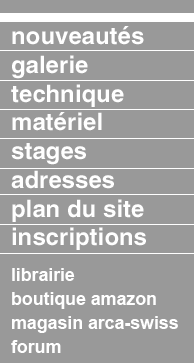
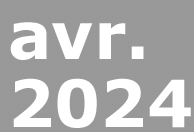
[abonnement gratuit]
the authors
|
Dan FROMM

Dan Fromm was born in 1944. He was educated as an economist and has
worked as an econometric model builder, economic forecaster, and applied
statistician. He has always refused to answer questions about share
prices. Photography is one of his avocations; he took up photography to
record life colors of the fishes he kept, bred and collected. In
addition to photographing his fishes, he has made and presented slide
shows and movies about his field trips.
contact :
danielwfromm(at)hotmail.com
|
HTML-WEB formatting
by Emmanuel Bigler
|
Emmanuel Bigler is a professor (now
retired) in optics and microtechnology at ENSMM, Besançon, France, an
engineering college (École Nationale Supérieure d'Ingénieurs) in
mechanical engineering and microtechnology.
He got
his Ph.D. degree from Institut d'Optique, Orsay (France).
E. Bigler
uses an Arca-Swiss 6X9 FC view camera.
Mail

|
See in pdf
L'article en français
|
|
Apo-Nikkor and Process-Nikkor large format lenses
by Daniel W. Fromm
1 Apo-Nikkors, according to
Nikon
Nikon made two families of Apo-Nikkor lenses, both intended to be
used for, e.g., photoengraving. These are, respectively, dialyte
types (“Symmetrical Type Apo-Nikkor”)and Tessar types (“Asymmetrical
Type Apo-Nikkor”). Nikon claims that all of them have low distortion
(“almost zero” at 1:1) and are highly corrected for three colors, (“red,
green, and blue”). “The highest sharpness will be attained when the
aperture is stopped down by 2-3 stops from the maximum. When the
aperture is reduced by 2 stops, a uniformly bright image area will
be obtained without vignetting at the corners of the image field.”
“Even when the aperture is stopped down, the image is maintained in
the same position, so that focusing can be done at maximum
brightness.”
I have an old Nikon catalog that says this about the two types:
1.1 Symmetrical Type Apo-Nikkor
Each Apo-Nikkor of symmetrical type, consisting of a
symmetrically arranged optical system consisting of 4 groups and 4
elements of lenses, has the following features:
-
The lenses will give a wide effective
picture angle (about 46º) for their long focal length. Therefore,
the image area being assumed the same, a camera of shorter
length can be used.
-
Since the lens system is symmetrical in
respect to the iris diaphragm, the optical performance remains
the same, regardless of the direction in which the lens is used.
No need to reverse the lens for magnification. This greatly
facilitates the use of the lenses mounted on a camera with
automatic focusing device.
-
The lenses are also suitable for work,
where no distortion is permissible at a reproduction ratio close
to full size. On the other hand, since the lenses give an
excellent image, for a wide picture angle at infinite distance
as well as in enlarging work, they can also be utilized for a
large size camera or on an enlarger.
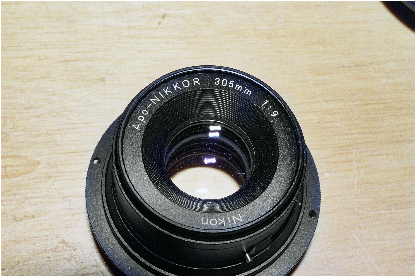 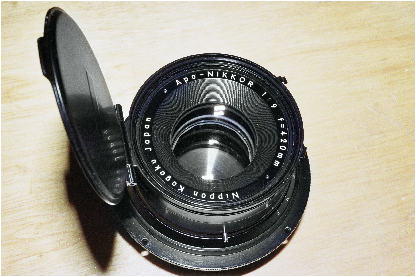
|
Figure 1: Symmetrical Apo
Nikkor lenses, dialyte type, focal lengths 305
and 420 mm |
 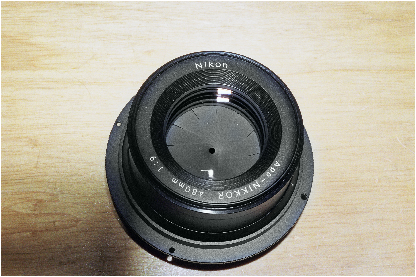
|
Figure 2: Symmetrical Apo
Nikkor lens, dialyte type, focal length 480 mm |
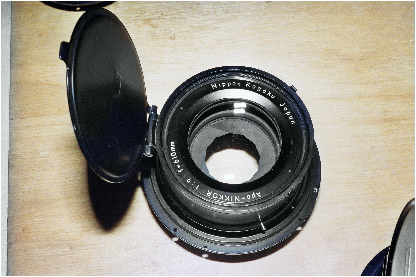 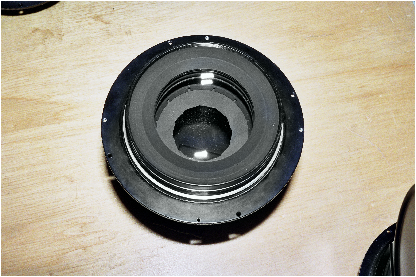
|
Figure 3: Symmetrical Apo
Nikkor lens, dialyte type, focal length 610 mm |
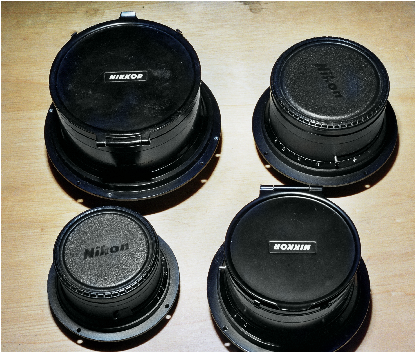 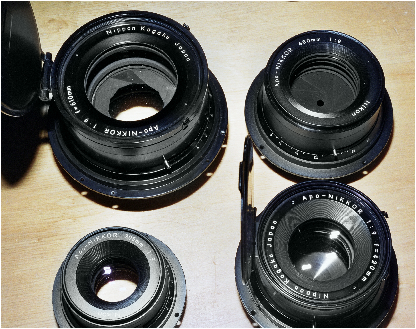
|
Figure 4: Four Symmetrical
Apo Nikkor lenses, dialyte type |
1.2 Asymmetrical Type
Apo-Nikkor
The asymmetrical type Apo-Nikkor lenses are intended primarily
for reproduction of Japanese and Chinese characters. They have a
rather narrow picture angle in order to attain highest resolving
power. They can also be used as reproduction lenses in electrostatic
photography and microphotography, as enlarging lenses for color and
monochromatic photography, and in connection with general purpose
cameras like view-cameras and studio-cameras.
2 Process-Nikkors, according
to Nikon
Nikon made four Process-Nikkor lenses, all four elements in four
groups double Gauss types with minimum aperture of f/32. Very
similar –identical, but for the name – lenses were sold as Nikkor-Q
before the name Process-Nikkor was used. Nikon does not claim
that these lenses are apochromatic and does not recommend
that they be used outside their usable range of magnifications.
I have a Nikon catalog that says this about them:
The wide picture angle design of Process-Nikkor lenses makes for
larger subject area coverage than obtained with conventional lenses
at the same working distance. In addition, this distance can be
reduced for the same subject area, meaning the camera equipment can
be compact.
Although the maximum aperture ratio is 1:10, these lenses have
large diameters and minimal vignetting… 68° subject area coverage at
full aperture or 74° coverage when stopped down to f/22.
Process-Nikkor lenses assure remarkable flatness of the image
over the entire image area. They provide quick and low-cost
photoengraving for monochromatic reproduction.
The lens construction is 4 elements in 4 groups, and their
configurations are symmetrical so they can be used for either
enlargement or reduction without reversing.
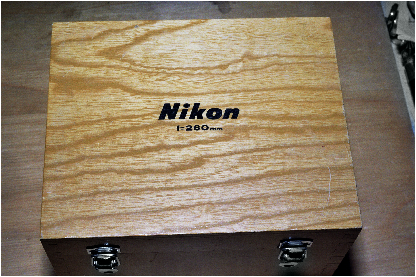 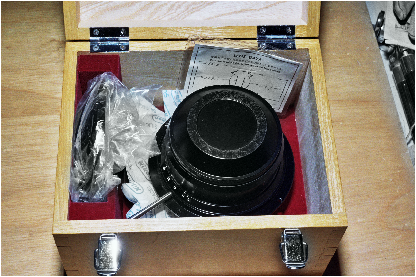
|
Figure 5: Process-Nikkor or
Nikkor-Q lenses, double-Gauss type, were
supplied in a nice wooden box |
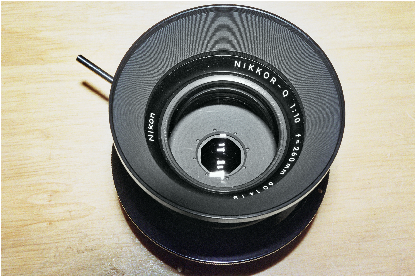 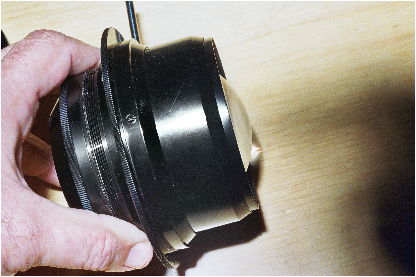
|
Figure 6: Nikkor-Q lens,
double-Gauss type, focal length 260 mm; note the
protruding rear lens element of this particular
design. |
|
f |
max |
|
|
mount |
weight |
|
(mm) |
aperture |
type |
coverage |
(mm) |
(g) |
|
150 |
f/9 |
tessar |
45º |
53x0.75 |
175 |
|
180 |
f/9 |
dialyte |
46º |
53x0.75 |
210 |
|
210 |
f/9 |
tessar |
45º |
53x0.75 |
185 |
|
240 |
f/9 |
dialyte |
46º |
53x0.75 |
220 |
|
300 |
f/9 |
tessar |
41º |
53x0.75 |
240 |
|
305 |
f/9 |
dialyte |
46º |
72x1 |
430 |
|
360 |
f/9 |
dialyte |
46º |
72x1 |
470 |
|
420 |
f/9 |
dialyte |
46º |
90x1 |
780 |
|
450 |
f/9 |
tessar |
37º |
72x1 |
550 |
|
455 |
f/9 |
dialyte |
46º |
90x1 |
810 |
|
480 |
f/9 |
dialyte |
46º |
90x1 |
860 |
|
600 |
f/9 |
tessar |
37º |
90x1 |
775 |
|
610 |
f/9 |
dialyte |
46º |
110x1 |
1450 |
|
750 |
f/9 |
tessar |
37º |
110x1 |
2015 |
|
760 |
f/11 |
dialyte |
42º |
110x1 |
1360 |
|
890 |
f/11 |
dialyte |
42º |
162x1.5 |
3600 |
|
900 |
f/9 |
tessar |
37º |
140x1.5 |
3570 |
|
1070 |
f/12.5 |
|
|
|
1600 |
|
1200 |
f/9 |
tessar |
37º |
213x1.5 |
8385 |
|
1210 |
f/12.5 |
dialyte |
40º |
162x1.5 |
3800 |
|
1780 |
f/14 |
dialyte |
36º |
213x1.5 |
6430 |
|
1800 |
f/14 |
tessar |
35º 20’ |
213x1.5 |
8860 |
|
Table 1: Summary
of Apo-Nikkors’ characteristics |
| |
|
|
|
|
|
Magnifi- |
|
f |
max |
|
coverage |
mount |
weight |
cation |
|
(mm) |
aperture |
type |
f/10, f/22 |
(mm) |
(g) |
(usable) |
|
180 |
f/10 |
4/4 double Gauss |
68º, 74º |
62x1 |
350 |
1:4 - 4:1 |
|
210 |
f/10 |
4/4 double Gauss |
68º, 74º |
72x1 |
510 |
1:3 - 3:1 |
|
240 |
f/10 |
4/4 double Gauss |
68º, 74º |
82x1 |
730 |
1:2 - 2:1 |
|
(*) 267 |
f/10 |
4/4 double Gauss |
68º, 74º |
90x1 |
1070 |
1:2 - 2:1 |
(*) note: engraved 260 mm
|
Table 2: Summary
of Process-Nikkors’ characteristics |
3 Wide-angle Apo-Nikkors,
according to Nikon
Steve Hamley very kindly shared a Nikon brochure on these lenses
with me. The full text can be found at:http://www.largeformatphotography.info/forum/showthread.php?t=86484
Nikon made four Wide-angle Apo-Nikkors, all six elements in four
groups plasmat types with minimum aperture of f/128. Nikon says
explicitly that these lenses are apochromatic, "fully symmetrical,"
and that, although their published "usable magnification range" is
1:10 - 10:1, they "are equally suited for other precision optical
tasks, such as: … use with view cameras or large format studio
cameras."
|
f (mm) |
max |
type |
coverage |
mount |
weight (g) |
Magnification |
| |
aperture |
|
|
|
|
|
|
150 |
f/8 |
6/4 plasmat |
60º |
53x0.75 |
240 |
1:10 - 10:1 |
|
210 |
f/9 |
6/4 plasmat |
57º |
72x1 |
455 |
1:10 - 10:1 |
|
300 |
f/9 |
6/4 plasmat |
54º |
90x1 |
840 |
1:10 - 10:1 |
|
360 |
f/9 |
6/4 plasmat |
54º |
90x1 |
970 |
1:10 - 10:1 |
|
Table 3: Summary
of Wide-angle Apo-Nikkors’ characteristics |
See in pdf
L'article en français
Dernière modification : 2012
|


















